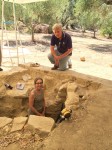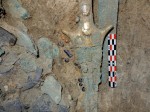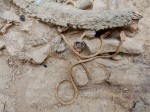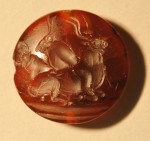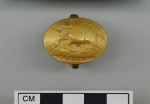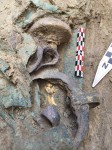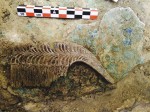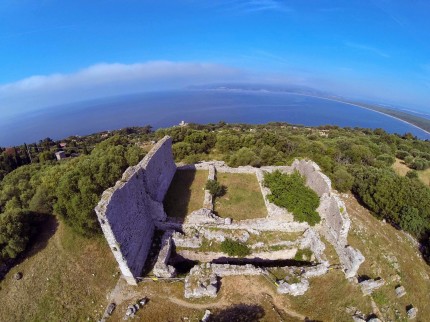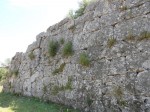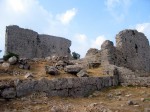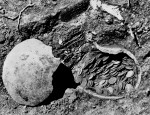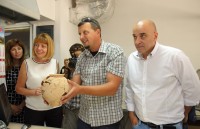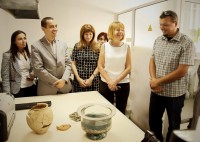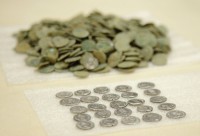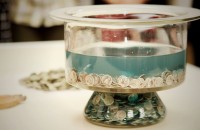When the Virginia Company sent the first batch of 104 settlers to colonize the New World, they chose Jamestown Island, marshy and mosquito-ridden with virtually no farmland, bad hunting and no fresh water but secure from any potential attack by Spanish ships, as the site for their new colony. They built James Fort, a triangular wooden palisade, within two weeks and the first Jamestown settlement was established inside its perimeter. It was small, but soon contained at least a storehouse, several houses and one church, the first Protestant church in the New World.
Built in 1608, the church served the community for almost decade. Secretary of the colony William Strachey described it as “pretty chapel” 60 feet long and 24 feet wide with a cedar wood chancel. In 1614 Pocahontas married tobacco planter John Rolfe there. Within three years of that wedding, the church had fallen into disrepair and was abandoned when a new church was built nearby as the settlement expanded eastward from the original confines of Fort James. Over time the location of the first fort and its church was lost.
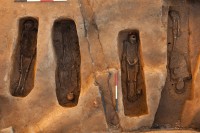 It was Strachey’s description that helped archaeologists identify the remains of the church when they were discovered during a 2010 excavation of the rediscovered Fort James site. The structural posts matched the dimensions documented by Strachey, as did the structure’s orientation in the middle of the fort. At the eastern end of the building, archaeologists found four graves. This space was the cedar chancel Strachey mentioned, the area in the front of the church with the altar which was reserved for the most important people during services. Only people of very high status were honored with burial under the chancel.
It was Strachey’s description that helped archaeologists identify the remains of the church when they were discovered during a 2010 excavation of the rediscovered Fort James site. The structural posts matched the dimensions documented by Strachey, as did the structure’s orientation in the middle of the fort. At the eastern end of the building, archaeologists found four graves. This space was the cedar chancel Strachey mentioned, the area in the front of the church with the altar which was reserved for the most important people during services. Only people of very high status were honored with burial under the chancel.
Since the archaeological site of Jamestown is open to visitors, the church remains were refilled for safety. Jamestown Rediscovery archaeologists, working with forensic anthropologists from the Smithsonian’s Museum of Natural History, returned in November of 2013 to fully excavate the graves in the hopes they might be able to identify the people buried there. The remains were under threat, as is the entire Jamestown site, by rising sea levels, and one of the skeletons had been significantly damaged by workers in 1938 (when the location of the fort was still unknown) unwittingly dug a trench through the chancel to install electric cable. The excavation revealed one body had been buried only in a shroud (the others had wooden coffins) and two of the people were buried with artifacts that could help identify them.
The team carefully unearthed and documented the graves, using a precision laser tool to record the positions of the graves, skeletons, coffin fragments and artifacts. Then the Smithsonian’s outstanding 3D Digitization Program Office did their magic, laser scanning the entire site, collecting millions of data points and high resolution photographs that would allow them to create an interactive 3D model of the burials. I won’t embed it because the last time I did it caused some loading problems, but here’s the 3D model of the chancel graves on the Smithsonian website.
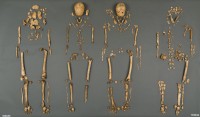 The skeletal remains were then removed to the lab for analysis. Time and environment had not been kind to them — only 30% of each skeleton was recovered — but the bones could still speak through science. All four were men who were between their early 20s and their 40s when they died, and all four were found to have carbon and oxygen isotope values indicating they were raised in England. None of them show the tell-tale osteological signs of strenuous labor, but the teeth of two of them were in bad shape with numerous cavities and abscesses. That was a clue that those two men may have been in America longer than the other two and had thus been exposed to a potentially tooth-rotting sweet corn diet for a few more years. High levels of lead in the bones of two of the men suggested they were high-born since in the 17th century the wealthy and noble ingested more lead than the poor courtesy of lead-lined and pewter tableware.
The skeletal remains were then removed to the lab for analysis. Time and environment had not been kind to them — only 30% of each skeleton was recovered — but the bones could still speak through science. All four were men who were between their early 20s and their 40s when they died, and all four were found to have carbon and oxygen isotope values indicating they were raised in England. None of them show the tell-tale osteological signs of strenuous labor, but the teeth of two of them were in bad shape with numerous cavities and abscesses. That was a clue that those two men may have been in America longer than the other two and had thus been exposed to a potentially tooth-rotting sweet corn diet for a few more years. High levels of lead in the bones of two of the men suggested they were high-born since in the 17th century the wealthy and noble ingested more lead than the poor courtesy of lead-lined and pewter tableware.
 The artifacts proved as challenging to study as they were revelatory. In the southernmost grave, archaeologists found a textile made of silk cloth, silver threads and silver spangles between the rib cage and left arm of the skeleton. A near-miraculous survival, the artifact was too fragile to be excavated and was removed in a soil block. X-rays found the hundreds of silver threads and spangles in the soil block. Micro CT 3D scanning revealed the object was a captain’s sash decorated with bullion fringe.
The artifacts proved as challenging to study as they were revelatory. In the southernmost grave, archaeologists found a textile made of silk cloth, silver threads and silver spangles between the rib cage and left arm of the skeleton. A near-miraculous survival, the artifact was too fragile to be excavated and was removed in a soil block. X-rays found the hundreds of silver threads and spangles in the soil block. Micro CT 3D scanning revealed the object was a captain’s sash decorated with bullion fringe.
 The two artifacts found in the other burial were placed in the grave outside the coffin. One was an iron fragment three inches long that turned out to be the finial below the tip of a ceremonial spear known as a leading staff. The other was a silver box placed on top of the coffin. The box was corroded shut, so the research team turned to X-ray and CT scanning in the attempt to see what might be inside. With help from increasingly higher resolution microCT scanners, gradually the silver box gave up its secrets. It’s a reliquary containing a lead ampulla, a vial used to hold holy water, oil or the blood of a saint, broken in two pieces and seven fragments of bone, also probably holy relics. Their final scans were so detailed they were able to 3D-print reproductions of the contents for examination.
The two artifacts found in the other burial were placed in the grave outside the coffin. One was an iron fragment three inches long that turned out to be the finial below the tip of a ceremonial spear known as a leading staff. The other was a silver box placed on top of the coffin. The box was corroded shut, so the research team turned to X-ray and CT scanning in the attempt to see what might be inside. With help from increasingly higher resolution microCT scanners, gradually the silver box gave up its secrets. It’s a reliquary containing a lead ampulla, a vial used to hold holy water, oil or the blood of a saint, broken in two pieces and seven fragments of bone, also probably holy relics. Their final scans were so detailed they were able to 3D-print reproductions of the contents for examination.
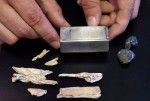 Reliquaries are Catholic and like other Catholic devotional objects they were outlawed by Elizabeth I and her successor James I. This box may be evidence of a crypto-Catholic presence in the colony, which is also supported by other more modest finds made elsewhere in Jamestown like pilgrim’s tokens, crucifixes and rosary beads.
Reliquaries are Catholic and like other Catholic devotional objects they were outlawed by Elizabeth I and her successor James I. This box may be evidence of a crypto-Catholic presence in the colony, which is also supported by other more modest finds made elsewhere in Jamestown like pilgrim’s tokens, crucifixes and rosary beads.
Thanks also to copious documentary research on likely candidates, the Jamestown Rediscovery team was able to identify the four men as:
- The Reverend Robert Hunt, the former vicar of Reculver, England, who arrived with the first settlers in 1607 and died aged around 40 between January and April of 1608.
- Captain Gabriel Archer, a bitter rival of Captain John Smith (he once called for his execution), who explored the interior along the James River valley. He died during the horrific “starving time” in the winter of 1609-1610 at the age of 35. The reliquary is his, and since his parents were Catholics, once fined for non-attendance of Anglican services, he could very well have been as well, only on the downlow.
- Sir Ferdinando Wainman, the earliest English knight known to have been buried in the New World, arrived in June of 1610 with his relative, the first governor of Virginia Thomas West, Lord De La Warr. He was appointed Jamestown’s master of the ordnance and cavalry, but he didn’t have a chance to serve for long as he died between July and August of 1610. He was 34.
- Captain William West, another relative of Lord De La Warr’s who arrived in June 1610 only to die within months. He was killed in battle against Powhatan warriors in the fall or winter of 1610. The glorious sash is his.
The two men with the high lead levels were Wainman and Archer.
The Historic Jamestowne website is excellent, packed with information on the history of the site and its ongoing archaeology. I strongly advise starting on the chancel burials page and clicking through the large icons which will lead to pages with other large icons beneath. In addition to detailed information on the four men, they have many videos related to this find, all short enough to binge on like popcorn one after the other.
This one about the church has footage of the 2011 excavation and shows how respectfully the site was refilled with mounds and crosses marking the four burials:
[youtube=https://youtu.be/6AfyJgODE2c&w=430]
The 2013 excavation of the burials:
[youtube=https://youtu.be/RM1_HeoVaUQ&w=430]
Overview of the discovery and identification of the skeletal remains:
[youtube=https://youtu.be/pkqmiVU58uw&w=430]
Flythrough of a 3D rendering of the chancel burials:
[youtube=https://youtu.be/upJDtnbxpaU&w=430]
Captain West’s fabulous silk and silver sash:
[youtube=https://youtu.be/7Jg5nNVB2JY&w=430]
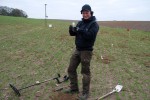 Robert Hemming Poulsen lays fiber-optic cable for a living. For fun, he takes his metal detector with him on assignments and explores new places in his downtime. Last month Poulsen was installing a fiber-optic network on the Danish island of Omø when he struck up conversation with farmer Hans Peder Tofte. Tofte told him that as a boy he had found a silver ring on his property. Intrigued, Robert took his metal detector to the field and discovered several silver fragments and silver coins.
Robert Hemming Poulsen lays fiber-optic cable for a living. For fun, he takes his metal detector with him on assignments and explores new places in his downtime. Last month Poulsen was installing a fiber-optic network on the Danish island of Omø when he struck up conversation with farmer Hans Peder Tofte. Tofte told him that as a boy he had found a silver ring on his property. Intrigued, Robert took his metal detector to the field and discovered several silver fragments and silver coins. 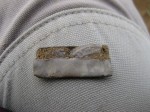 An experienced and responsible amateur, Poulsen stopped the search and alerted the Zealand Museum to his finds. With funding from the Danish Agency for Culture, the museum arranged for a more thorough exploration of the field. Last weekend museum experts joined Robert Poulsen and three of his experienced metal detecting friends to search the site. They discovered more than 550 silver fragments, silver coins, cuttings from silver coins and silver jewelry from the 10th century. This was an all-silver hoard.
An experienced and responsible amateur, Poulsen stopped the search and alerted the Zealand Museum to his finds. With funding from the Danish Agency for Culture, the museum arranged for a more thorough exploration of the field. Last weekend museum experts joined Robert Poulsen and three of his experienced metal detecting friends to search the site. They discovered more than 550 silver fragments, silver coins, cuttings from silver coins and silver jewelry from the 10th century. This was an all-silver hoard.  All of the artifacts were unearthed in an area about 100 feet in diameter suggesting they were originally buried in a single hoard. The field has been ploughed for hundreds of years, however, so if there was a container, it has long since been destroyed and/or rotted away. The team dug beneath the ploughed soil just in case, but all they found was clean sand. There are no indications of an individual house or settlement in the area. It appears that the treasure was simply buried in a field.
All of the artifacts were unearthed in an area about 100 feet in diameter suggesting they were originally buried in a single hoard. The field has been ploughed for hundreds of years, however, so if there was a container, it has long since been destroyed and/or rotted away. The team dug beneath the ploughed soil just in case, but all they found was clean sand. There are no indications of an individual house or settlement in the area. It appears that the treasure was simply buried in a field.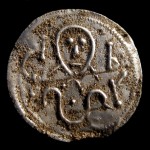 While most of the hoard is composed of fragments of hacksilver as small as .1 grams, including tiny cuttings of Arabic coins called dirham clips, it has a number of rare and important pieces. There are multiple coins from the reign of Harald Bluetooth. Minted between 975 and 980 A.D, the Harald Bluetooth cross-coins are considered the first Danish coins. They are so thin that the design on one side shows through on the other, and the silver content and weight are so low that metal detectors can’t detect them. Any find of Bluetooth coins, therefore, is always archaeologically significant.
While most of the hoard is composed of fragments of hacksilver as small as .1 grams, including tiny cuttings of Arabic coins called dirham clips, it has a number of rare and important pieces. There are multiple coins from the reign of Harald Bluetooth. Minted between 975 and 980 A.D, the Harald Bluetooth cross-coins are considered the first Danish coins. They are so thin that the design on one side shows through on the other, and the silver content and weight are so low that metal detectors can’t detect them. Any find of Bluetooth coins, therefore, is always archaeologically significant. Besides the Arabic and Danish coins, the hoard also contains silver coins from England, Germany, Poland and the Czech Republic. Some coins have yet to be identified. Three unidentified coins were found in an unusual configuration: one coin folded over the other two. Similar pieces have been found before in England, but they’re from later in the Middle
Besides the Arabic and Danish coins, the hoard also contains silver coins from England, Germany, Poland and the Czech Republic. Some coins have yet to be identified. Three unidentified coins were found in an unusual configuration: one coin folded over the other two. Similar pieces have been found before in England, but they’re from later in the Middle 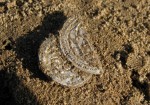 Ages and the they have one complete coin folded over a half coin thereby created a one-and-a-half denomination. All three of Omø coins in this configuration are complete.
Ages and the they have one complete coin folded over a half coin thereby created a one-and-a-half denomination. All three of Omø coins in this configuration are complete.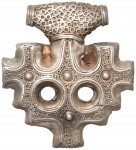

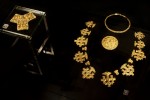
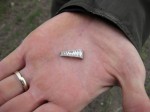 By Danish law, historical finds are treasure trove and property of the state. The Zealand Museum will thoroughly document and photograph every piece before sending them to the National Museum for valuation by experts. Finder Robert Poulsen will receive a reward based on the value of the hoard. The Zealand Museum hopes they will then get the hoard back for exhibition, but that depends on whether the National Museum deems its security measures sufficient to protect the find.
By Danish law, historical finds are treasure trove and property of the state. The Zealand Museum will thoroughly document and photograph every piece before sending them to the National Museum for valuation by experts. Finder Robert Poulsen will receive a reward based on the value of the hoard. The Zealand Museum hopes they will then get the hoard back for exhibition, but that depends on whether the National Museum deems its security measures sufficient to protect the find.